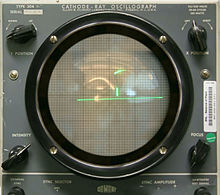
Back تنس فور تو Arabic Tennis for Two Azerbaijani Tennis for Two Byelorussian Tennis for Two Catalan Tennis for Two Czech Tennis for Two Danish Tennis for Two German Tennis for Two Spanish Tennis for Two Basque تنیس برای دو Persian
| Tennis for Two | |
|---|---|
 Tennis for Two on a DuMont Lab Oscilloscope Type 304-A | |
| Designer(s) | William Higinbotham |
| Platform(s) | Analog computer |
| Release |
|
| Genre(s) | Sports |
| Mode(s) | Multiplayer |
Tennis for Two (also known as Computer Tennis) is a sports video game that simulates a game of tennis, and was one of the first games developed in the early history of video games. American physicist William Higinbotham designed the game in 1958 for display at the Brookhaven National Laboratory's annual public exhibition after learning that the government research institution's Donner Model 30 analog computer could simulate trajectories with wind resistance. He designed the game within a few hours, after which he and technician Robert V. Dvorak built it over a period of three weeks. The game was displayed on an oscilloscope and played with two custom aluminum controllers. Its visuals show a representation of a tennis court viewed from the side, and players adjust the angle of their shots with a knob on their controller and try to hit the ball over the net by pressing a button.
The game was very popular during the three-day exhibition, with players lining up to see the game, especially high school students. It was shown again the following year with a larger oscilloscope screen and a more complicated design that could simulate different gravity levels. It was then dismantled and largely forgotten until the late 1970s when Higinbotham testified in court about the game during lawsuits between Magnavox and Ralph H. Baer over video game patents. Since then, it has been celebrated as one of the earliest video games, and Brookhaven has made recreations of the original device. Under some definitions Tennis for Two is considered the first video game, as while it did not include any technological innovations over prior games, it was the first computer game to be created purely as an entertainment product rather than for academic research or commercial technology promotion.